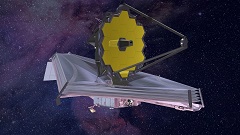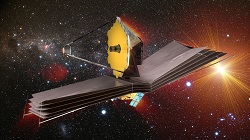James Webb Space Telescope

The James Webb Space Telescope (JWST) has been very much in the news over the last few months. Launched on Christmas Day 2021, the telescope reached its destination, nearly 1 million miles from Earth, where it went through the complex stages of deployment.
So then – What is it?
Quite simply, the JWST is the largest and most powerful space telescope ever built. If the deployment is successful, the expectation amongst the science community is that the JWST will herald a new age in astronomy. The technology is far superior to that of Hubble. It will allow scientists to look back in time to the first light of galaxies in the observable universe only 200 million years after the big bang. It will also be able to observe objects in our own solar system with detail never seen before; with an ability using infrared to see definition through dust clouds. The JWST will be able to examine the atmospheres of planets orbiting stars.

The telescope is very big. To make it possible to launch into space, the team had to devise a method of folding it up so it would fit inside the rocket. Once in space, it has unfolded to a size as tall as a three story building with an area as long as a tennis court. The reason it is big, is because the bigger the mirror, the greater the detail. Launching such a large mirror as a complete piece was not possible and so the engineers have created 18 hexagonal pieces on a hinged structure - smaller mirrors that fold together for launch. These mirrors, coated with a thin layer of gold, need to unfold and fit together precisely. They are coated with gold because it helps to reflect the infrared light. To protect the mirror and the heat sensitive cameras from the Sun, the telescope has a sun-shield which is the size of a tennis court. It is important to protect the telescope from the heat of the Sun because the telescope sees infrared radiation. The JWST infrared cameras can see through dust clouds in the same way the cameras firemen use can see through smoke. Looking into and through the dust in the Universe could lead to exciting new discoveries.
After it’s million mile journey, the telescope has taken up an orbit of the sun in line with the Earth. The area of orbit is known as a Lagrange point. A Lagrange Point is a position in space where the gravitational forces of the Sun and the Earth balance the centripetal force, allowing the spacecraft to move with them. The Lagrange Point is particularly useful as it reduces the amount of power needed for the spacecraft to remain in position and allows continuous communication through the Deep Space Network; an international array of antennas managed by NASA at the Jet Propulsion Laboratory.

Fully deploying the telescope takes time. With the mirrors unfolded, each mirror then needs to be aligned. The alignment is done with movements measured in nanometres. There are 25.4 million nanometres in one inch. Although painstaking, it's essential that each position is exactly right, so that the telescope can function correctly. Once commissioned, the mirror will feed the light from the cosmos into four instruments designed to take images and analyse the chemical composition using cutting edge spectroscopy. NIRSpec is the key onboard instrument for spectroscopy and discovering the chemical composition of stars and exoplanets. The other instruments are NIRCam, FGS/NIRISS and MIRI – all packed with Cameras, Spectrographs and Coronagraphs.
At the time of writing this, the JWST has made its journey and unfolded from its packed state. Despite this, it will still be months before the telescope is commissioned and the first images make their way to the expectant wide eyed scientists and public. It will however, be a wait well worth waiting for if everything goes to plan. The images promise to be breathtaking with an appeal, in equal measure, to scientists, poets and dreamers.




